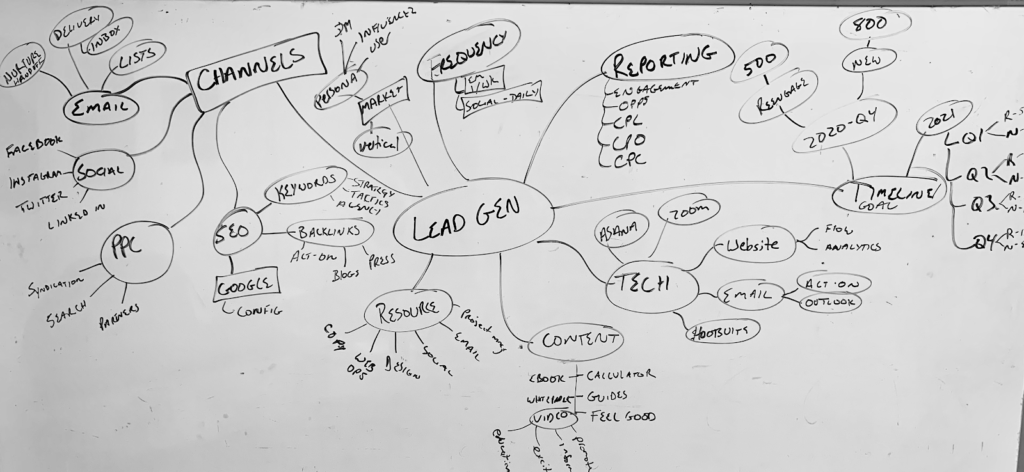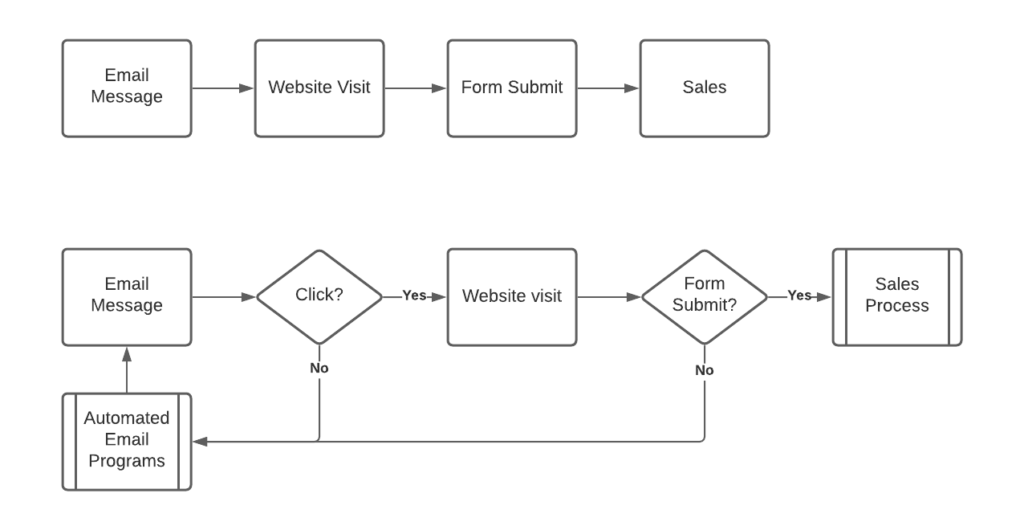6 Steps for Developing a Tactical Marketing Plan
Learn more about the psychology of our marketing plans
by downloading our infographic here.
I read an article this week titled “Why 67 Percent of Strategic Plans Fail, Strategic planning is great, in theory, but more often than not, it fails. Here’s why.” It outlined that 74% of executives report not having faith in their company strategies, and 67% of strategic plans fail. The author then continued to outline three steps to resolve this:
- Think from the outcome realized and work your way back
- Master enrollment conversations
- Ensure quality is present
The article read like fluff. As a business owner, I hate this kind of advice. Many consulting firms live in this world of gray advice that could just as easily have been generated by fortunecookiemessage.com. It’s not that the advice is necessarily wrong; it’s just not practical.
What I read is, “Is your strategic plan failing? Try developing a strategic plan about it.” There is a stark difference between “strategic plans” and “tactical plans.” A strategic plan focuses on macro initiatives and objectives; a tactical plan gets things done.
Strategic plans are easy. Tactical plans are hard.
In marketing, we see this problem in our everyday lives. It’s easy to construct a marketing strategy for most organizations. It always sounds clever and goes like this: Personas, lifecycle stages, targeted advertising, retarget nurture, sales stage, onboarding.
And now I’m a marketing genius.
This is very much like a general who orders an army to “take the hill”:
General: “Take the hill.”
Captain: “Fantastic. Great. Neat idea, General. Sergeant, take the hill!”
Sergeant: “The enemy has machine guns, tanks, and razor wire fortifying their position. How exactly do you think we should take the hill?”
Captain: “That’s your problem. Follow your orders, sergeant.”
The hard part about marketing isn’t about knowing what to do; it’s knowing how to do it.
Let’s break down “Targeted Advertising.”
This is “lead generation” and often the area most focused on by our customers. Some campaigns work, others don’t, and most often, people have no idea why. The truth is, there is a world of specialization in this one step that requires numerous nuanced tactical plans. Some of the many components include:
- How many different ads should we have?
- What marketing channel?
- What marketing source?
- What is the theme or topic of the ad?
- What is the incentive for the buyer?
- What is the frequency of the ad?
- What is the expected metric of the ad?
- What is the rate of delivery of the ad?
- What is the cost of the ad?
- What is the evaluation period of the ad?
- How will we know if the ad is working?
And so on and so forth.
Once you’ve answered any individual question, it spawns new questions. When this process is unfocused, everyone is trusting their gut instead of making informed decisions, and bad things happen. Copywriting gets overwhelmed, Design can’t keep up, Sales isn’t getting fed, and everyone starts blaming each other. Suddenly, instead of “throw it against the wall and see if it sticks,” you’re throwing everything against the wall and hoping anything will stick.
At some point, the CEO asks for an ROI calculation, and it’s chaos as everyone tries to put together a cohesive story, knowing the real answer is “Aaaaaghhhh! We’re on fire!” Then people get fired, and we start all over again. Fun times.
Strategic plans fail without tactical plans to support them.
Tactical plans use mind maps and flow charts to think through every scenario before we even start. They don’t always work out the way we expect them to, but each step informs the next. Each roadblock has a defined alternative, and companies are able to pivot at each stage. Most importantly, you can see trouble coming and avoid it.
Tactical plans are long, boring, and incredibly effective.
Here’s my 6 step process for developing a tactical marketing plan:
- Create a mind map
- Create a flow chart
- Create a dashboard
- Write it all down
- Execute
- Adjust
1. Create A Mind Map

(Disclaimer, I stopped before I finished. It was just supposed to be an example.)
Define your stage objective, break it down into all of its components, then break those components down into sub-components. Nothing can be considered done until it has at least three layers.
Think through everything, especially the pieces that don’t feel important. As I was writing this article, I decided to draw a quick mind map for lead gen — an exercise I have done a million times — only to realize I was running out of whiteboard space for everything I needed. As each bubble became its own budget and department, I remembered: our job is hard and complicated. But oh, so worth it.
2. Create a Flow Chart

Flow charts identify each step that needs to be implemented for the action to be complete. In flow charts, there are three key symbols that are important to remember:
1. Decision. This step identifies where a true/false, yes/no decision can be made. The most common error: “What happens if false?” When we document existing processes for our customers, the most significant gap is that false conditions have been overlooked.
Example: If the person engages with the email campaign, send them to sales. What do you do if they don’t engage?
2. Process/Step. Break your process down into each granular, linear step. This will very commonly identify any gaps. Certain things must happen for the next step to occur. When combined with Decision symbols, they will also expose redundant or recursive inefficiencies that can be streamlined out of the process.
3. Predefined Process. Sometimes a series of steps occur that are represented as one “step” in your diagram. These need to be represented differently than single steps because it assumes that the “other” process is optimized and efficient.
Example: Using a software application to segment an audience into lead gen, nurture, sales, and customer groups can be represented as “Segmentation” because it has its own set of rules and logic flows to govern it. When we see these together, the contrast between a poorly-thought-out flow chart and a correctly built flow chart becomes very obvious.
3. Create a Dashboard

Anything worth doing is worth doing right. If you are planning to run social media ads, invest in PPC, or send an email, you need to research and define expectations. Once you have defined your expectations, you should clearly articulate how these components will be measured and assemble the pieces to track, measure, and improve performance.
For example, you are using social media to promote your service or products. Post-performance metrics are great, but the native reporting doesn’t tell you much beyond vanity metrics. Ideally, social media results in website visits, which leads to form submissions, follow-up emails, sales opportunities, and/or new customers.
Correlating this data for reporting requires defining how it will be tracked and measured in advance. This will help you define what tracking pixels need to be placed, what UTM or other parameters need to be appended, and what hidden fields need to be in your forms to collect and measure performance accurately.
4. Write It All Down
In 20 years, I have yet to meet someone who actually had all the pieces in their head. Brilliant marketers cannot possibly have simultaneous mastery over the 87 specialized disciplines that make up our field. Even a one-person marketing team will need to communicate with executives, salespeople, and contractors. Most importantly, if you are building a tactical marketing plan correctly, you will need to communicate with your future self because you will forget.
“The shortest pen is better than the longest memory.”
5. Execute
You’ve planned the work: now work on the plan. It’s tempting to chase shiny, new things. If people like me are doing our job right, we will distract you with our marketing for some shiny new software, some great new tool, some “low hanging fruit” that you are missing. Once you have written your plan, it is imperative that you stick to your plan. Anything new can go into the next one.
6. Adjust
If your dashboard is working, you will see progression to your goals on the timeline you have established. If you’re lagging, then something isn’t working, and it’s essential that you follow your flowchart to find the broken step. To quote Ben Horowitz, “There is no silver bullet that’s going to fix that. No, we are going to have to use a lot of lead bullets.” Average marketing is easy. Good marketing is hard — it takes a lot of planning, a lot of work, and a lot of optimization. At the end of the day, it is all just math and flow charts that lead to your outcome. This diagnostic approach requires that we monitor and adjust to keep the leads coming and deals closing.
“It is not the critic who counts; not the man who points out how the strong man stumbles, or where the doer of deeds could have done them better.”
Tactics are the mechanics by which we implement a strategy. Tactics are messy, gritty, sometimes boring, and the difference between finding success or failure. I waste no time listening to the fools who give generic strategic feedback. “Make it more scalable,” “use micro-targeting,” and “really drive to the CTA” are at best objectives, not plans. At worst, it’s bullshit masking ignorance. It’s an attempt at plans that rely on the magic of positive intentions. The reality is, if your plan requires magic, it’s a bad plan. I live in a world built on empathy for other marketers. Often the expectation is to accomplish the impossible with limited resources. I chose this life because it is hard and because I like solving impossible problems. I see my strategic plans work (most of the time) by making very good, very granular tactical plans that don’t have silver bullets or magical outcomes.
Download our Personalized Marketing Automation Methodology Guide to learn more about the psychology of our marketing plans.





